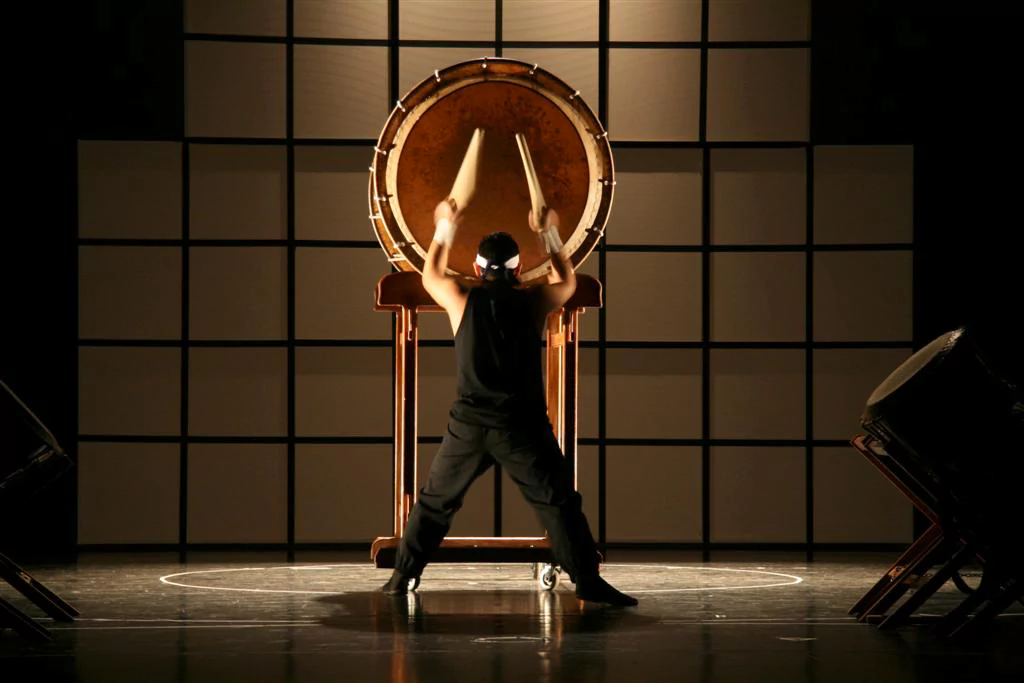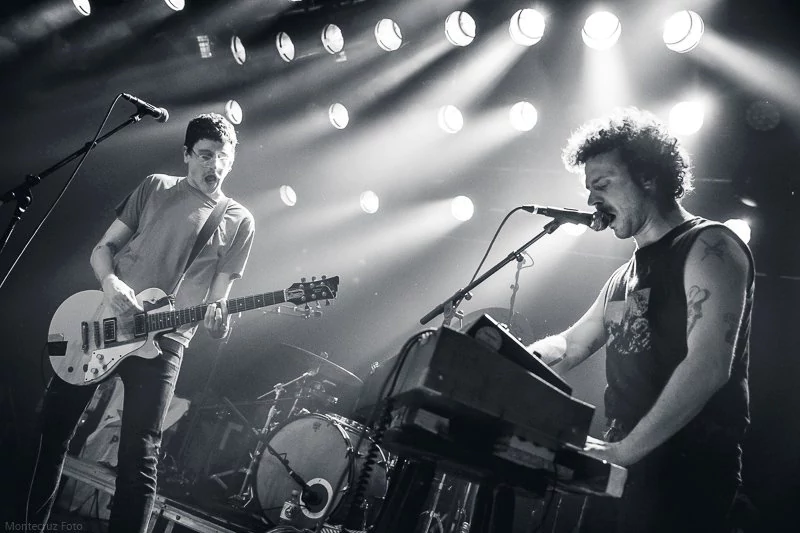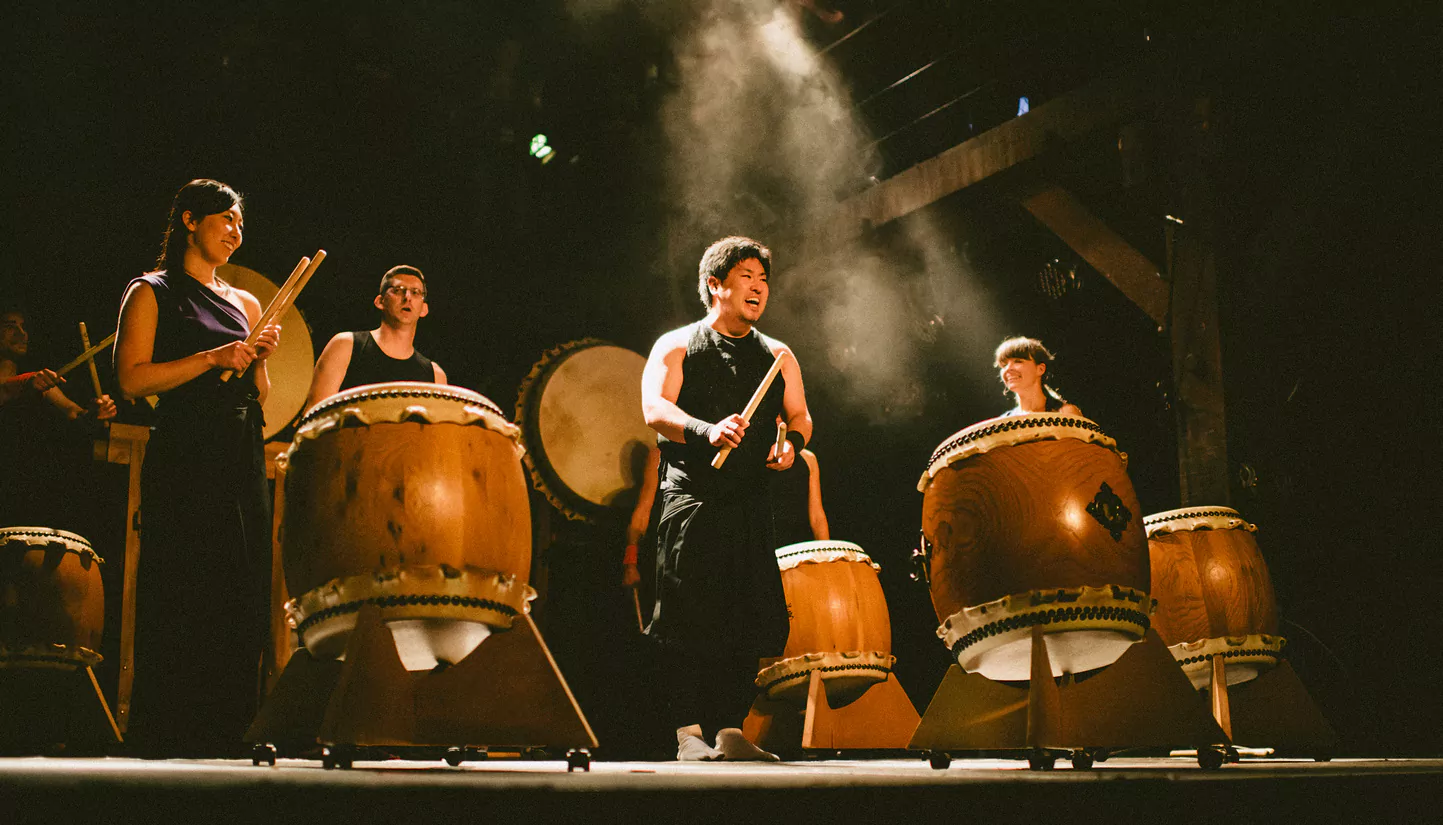I. Historical perspective: from rites of Shinto to a sign of globalization
Primitive ideas Minimal agreements were reached in the beginning

Taiko drums originated during the Neolithic Age in China. Pottery drum-shaped vessels were first found on the Yangshao culture site, dating back about 6,000 years according to archaeological findings. The discovered “crocodile drum”, a sacred musical instrument whose shell is covered with crocodile skin and whose cavity is made of wood, found in the Taosi site in Shanxi Province validated the record of “crocodile drums” in the Book of Songs. In the Shang and Zhou dynasties, the bronze drums and the “earth drums” recorded in the “Book of Rites” developed in parallel and became important ritual instruments for sacrifice and military. This type of drum entered the Japanese archipelago, through the Korean Peninsula, around the same time as the spread of agricultural culture in the Yayoi period (about 300 BC-300 AD).
The eastward spread of mainland drum music technology is directly reflected in the “Wu drum” of the Tang Dynasty collected in the Shosoin Repository in Nara. But during the process of absorption, Japan implemented localization transformation: The Jomon period “earthen drums” were mostly used in witchcraft, and gradually grew an exclusive Taiko shape and play method in the Heian period, and eventually formed the systematic Taiko culture in the Muromachi period. The evolutionary history of this musical instrument vividly reflects the cultural dissemination feature that East Asian civilization “same origin, different streams”.
In Shintoism, the sound of Taiko is the breath of God that connects heaven and the earth.
Modern organizations, such as the IT company in Kyoto, adopt the “data purposes” Taiko rite to invigorate the technical processes, promoting a feeling of purpose among team members.
In the Warring States period, companies had regular methods.
The “Red Guards” of Takeda Shingen Use 2 meter (6.6 ft) Diameter Taiko Drums to Convey Tactical Information Its code system is as difficult as the contemporary Morse code.
Nissan had a rhythmic experiment with the production line, which reduced the failure rate by 18% by changing the pace of assembly according to the different drum beats (The Journal of Intelligent manufacturing, 2023).
Folk Music Events: The Foundations of Stronger Communities

Edo period ceremonial taiko with regional flavor include Akita Phone Ondeko and Okinawa’s Ryukyu taiko.
Multinationals borrow local idiosyncrasies and filter them thousands of times and return them as raw materials for cultural sensitivity courses. At Unilever’s Asia-Pacific headquarters, employees from abroad are required to be trained in reading the local Taiko style.
II. When Does the sustitución of Textbooks Occur?
Acoustics at Home in a Teachers’ Holistic, Component Phenomenal Education.
Helsinki’s Kallio Elementary School takes the national curriculum and a taiko project, whereupon the students use the forms to understand environmental science and variations in climate.
This approach of integration contributed 23% increase in standardized test score and got the concentration of students around 41% (OECD, 2012014).
Brazil: The Social Healing of Slums
In Rio de Janeiro, the initiative known as “Favela Drums” trades the issue of gang culture for taiko and members have to adhere to some strict rules.
This endeavor has decreased the youth viole͏n͏ce rate by38%, which opened doors to the development of the first taiko ensemble from a slum to perform at Carnegie Hall.
Middle East: Heiring toward gender egalitarianism.
All-female Taiko groups were approved by the Dubai Arts Authority to showcase this male-dominated traditional style with drums.
The collective has become something of a chic emblem of cultural evolution in the Gulf region, and its take on One Thousand and One Nights Drummers has been heard 230 million-plus times on TikTok.
III. The biological code of collective motion/Neuroscience deciphering
Neurons are very active in the mirror range.

A study from Oxford University showed that the mirror neurons firing in a Taiko ensemble worked 300% harder than they did in a chorus.
Using this information, Goldman Sachs developed a M&A training program. This program accelerated cross-cultural negotiations efficiency by 27%. Through drumming.
Specific Taiko patterns that was backed up by the study of Waseda University can produced the coupled oscillatory phenomeon of θ waves (creativity) and γ waves (concentration).
These are, earbuds that stimulate creativity that have been actually designed by Sony Music Entertainment, and they solve issues with composition using custom sound waves.
Application to touchers of synesthesia
Approximately 30% of long-term practicers will have “Sound-Tactile Synesthesia.”
While the Harvard Medical School’s research is trying this to alleviate the pain of phantom limbs, the BMW design team is creating a tactile feedback steering wheel for navigational assistance.
IV. Geo-rhythm: The Taiko framework and the new cultural cold war
Africa: The Rhythm as a marketing for the construction of infrastructures.
The “Silk Road” was dedicated to the African railway project for the Chinese aid team to Africa (Institute of African Studies, Peking University), reducing the overall local protests by over 60%.
The cultural resistance of the Arctic Circle, indigenous.
Sami Music Meets Taiko Drums for Climate Change Advocacy

It was originally scheduled to be finished in time for COP28, the United Nations climate change conference taking place in Dubai, where the Burj Khalifa lies.
Metaverse: digital colonization and cultural return.
It has more than 100 million players globally, and the game “Taiko no Tatsujin: Metaverse” has a mechanism of “cultural redemption,” which preserves 87 endangered drumming methods.
V. Looking ahead: Computers and robots take the reins
Quantum Taiko, and TPC as a whole, is an exploration of time and space.
Also known as, the quantum Taiko device at the MIT Media Laboratory that can transmit the sound from the past present future at the same time.
Bio-fusion cydor
And at the University of Tokyo, they made a “biological taiko” out of the genetically altered material – spider silk that improves sports safety by 55%
The airborne cultural evolution stratagem
NASA’s “Voyager Golden Drum” program supports launching titanium-based taiko into space in order to automatically strike the music of the spheres.
Outcome: Continuous evolution
The taiko is more than just an update of an ancient instrument for modern times; it represents a yearning for people to join forces to create a common rhythm. “I think the leaders of the future are going to need two required classes: quantum computing and taiko ensemble,” said Irene Sakamoto, a professor at Stanford University.



